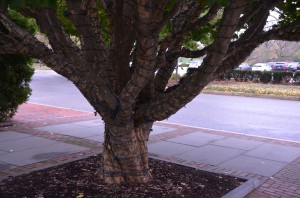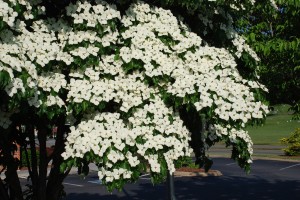Chinese dogwood, aka kousa dogwood, (Cornus kousa) is a small 25 to 35 foot flowering tree (USDA hardiness zones 5-9). It grows in either full or partial sunlight (4-hours sunlight minimum). Depending where you garden, kousa dogwood begins blooming from late April or in May, almost two weeks after our native flowering dogwood (C. florida) has finished flowering.
Kousa dogwood is a tree for all seasons. New leaves emerge shortly before the tree flowers. The creamy white, four-pointed bracted flowers expand to 4 to 5 inches across. Pink blooming cultivars are a rare find. Aggregate green fruits, similar in shape to oversized blackberries (size of a nickel or larger), ripen orangey-red in September. Most birds do not relish them, but I’m told that monkeys love them.
Seedling kousa dogwoods exhibit wide variability in form, height, flower traits, leaf markings, and autumn leaf coloring. The 2-4 inches long summer leaves are generally dark green and glossy; variegated leaf cultivars are available. Leaf margins may be wavy or ruffled. Fall leaf colors varies from dull purple to crimson red. Bark mottling begins after 5-7 years as thin chips begin to flake off the main trunk and main branches. Some mature 50 plus year old trees are stunningly beautiful in the winter.
Young Kousa dogwoods often grow shrub-like. You can easily develop a tree framework by pruning; eliminate all root suckers and thin out inner branches to stimulate flowering.
Plant in a well-drained, moist, slightly acidic soil. Fertilized and mulch in early spring and irrigated during prolonged drought spells as this dogwood is only moderately drought tolerant.
Kousa dogwood possesses above average disease and pest resistance. Several hybrid dogwood cultivars are marketed with kousa as one parent. One novelty hybrid cultivar (C. nutalli x kousa) is Venus® which struts 6-7 inch wide white bracts; flower numbers are fewer, but are enormous in size.



 Posted in
Posted in 
